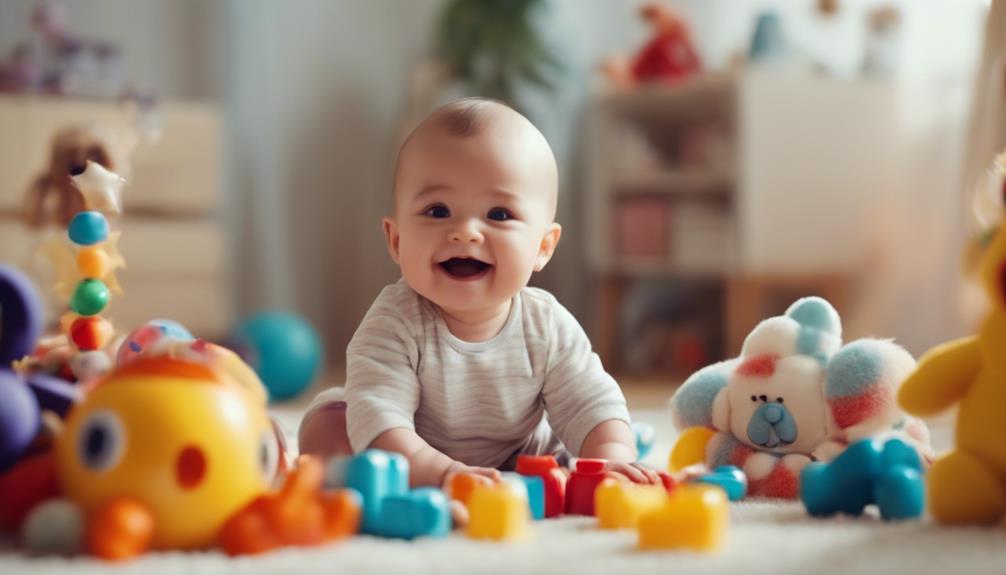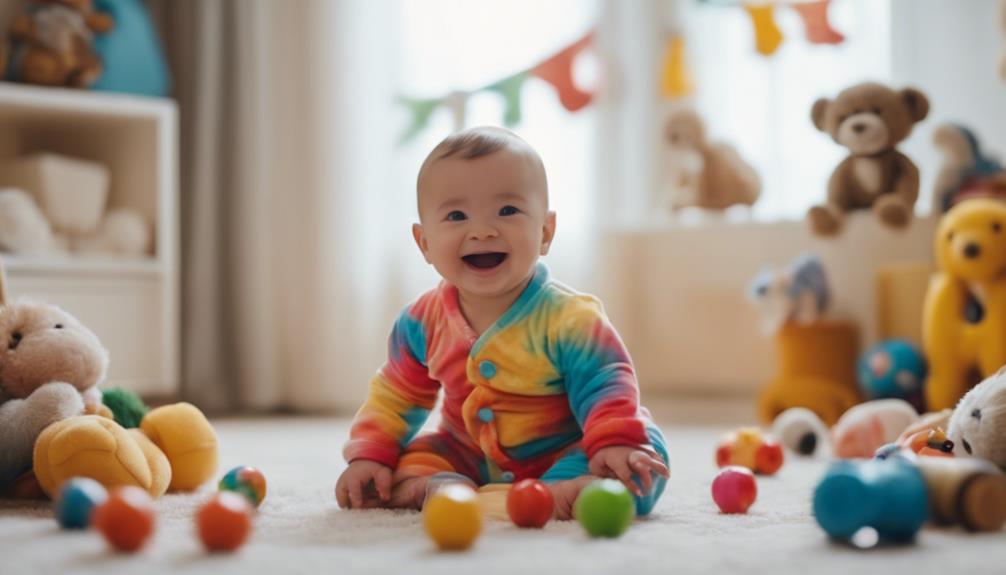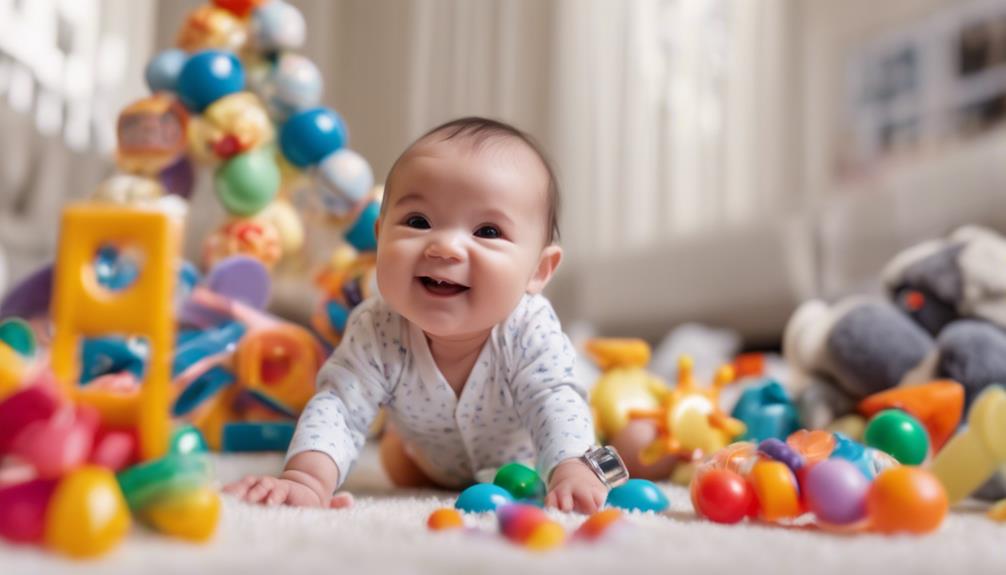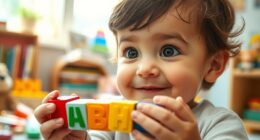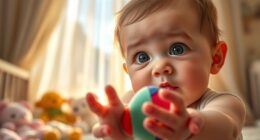Your baby’s essential smiles reflect a deep sense of joy, showcasing their natural ability to connect with others and express happiness effortlessly from a young age. Understanding the science behind these smiles can help us understand their role in forming bonds and improving communication skills. Social smiling is a crucial tool for building emotional connections with caregivers and peers, demonstrating your baby’s desire to participate in social exchanges. As infants reach important milestones, they use smiles to convey emotions, laying the groundwork for future interactions. Discover the reasons behind your baby’s happiness and the fascinating realm of infant joy.
Key Takeaways
- Infants smile instinctively to connect and express joy.
- Social smiles form emotional bonds with caregivers and peers.
- Positive interactions influence a baby's smiling behavior.
- Different types of smiles convey various emotions and intentions.
- Cherish and nurture your baby's happiness to strengthen your bond.
The Science Behind Baby Smiles
When delving into the fascinating world of happiness, it's essential to first explore the scientific intricacies behind the heartwarming phenomenon of baby smiles. Infants smile instinctively, beginning around 6 to 8 weeks in response to stimuli like faces and voices.
Research indicates that babies time their smiles deliberately, aiming to elicit reciprocal smiles from caregivers. Duchenne smiles, characterized by raised cheeks and pinched eyes, demonstrate a deeper level of engagement and focus. These smiles are vital for building social connections and fostering communication skills in infants.
Furthermore, joint attention plays a significant role in social development, as babies learn to coordinate their gaze with others during smiling exchanges. This early form of communication gradually evolves into more sophisticated interactions as infants grow and mature.
Social Smiling Explained
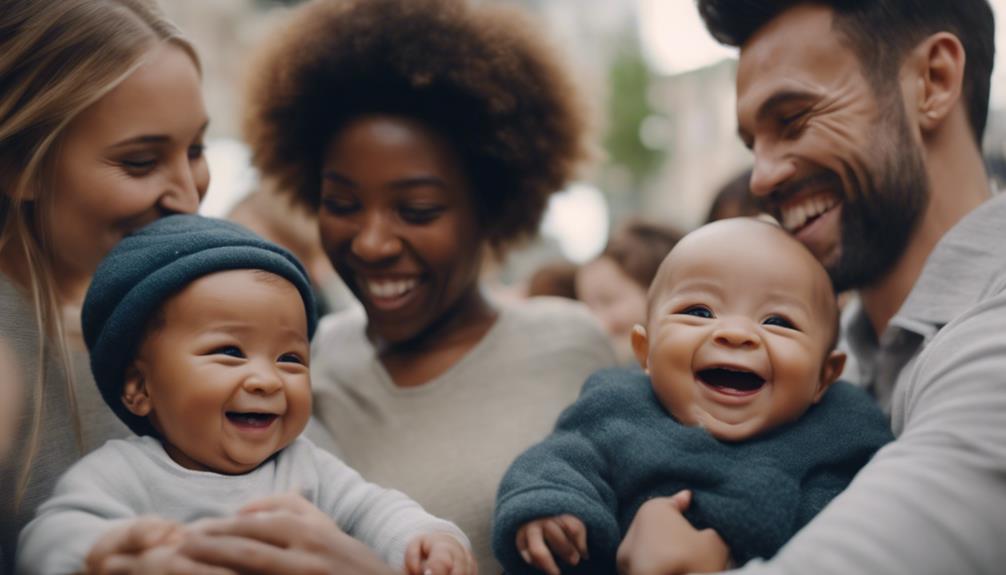
Social smiling in infants is an essential form of communication, allowing them to form emotional connections with caregivers and peers. Through their smiles, babies express pleasure, excitement, and happiness, fostering social bonds and shared experiences.
Understanding the significance of infant social smiles can provide insight into the early development of communication skills and emotional connections.
Infant's Social Smile
The emergence of an infant's social smile typically occurs around 6 to 8 weeks in response to various stimuli like faces and voices. This smile isn't just any smile; it's a crucial milestone in your baby's development.
When babies smile socially, it shows their growing ability to connect with others and convey feelings of joy and excitement. You'll notice raised cheeks, eye crinkles, and a genuine expression of happiness when your little one flashes a social smile.
These smiles aren't just random; babies use them purposefully to engage with caregivers and understand the dynamics of social interactions. It's a way for them to communicate their positive emotions and seek responses from those around them.
Emotional Connections Formed
Understanding emotional connections formed through social smiling in infants can provide valuable insights into their early social and emotional development.
When your baby smiles in response to your face or voice, they aren't just displaying joy; they're building an essential emotional bond with you.
These early social smiles act as a bridge for your baby to connect with you and others, signaling their pleasure and excitement. As they engage in social smiling, babies also enhance their visual acuity, recognizing familiar faces more readily.
By reciprocating these smiles, you reinforce their sense of security and belonging, laying a foundation for healthy social interactions in the future.
Communication Through Expressions
When babies engage in social smiling, they effectively convey their feelings of joy and seek positive interactions with caregivers and others around them. Social smiling typically starts around 6 to 8 weeks of age and plays a vital role in infants' communication and social development.
Here are some key points to help you understand how babies communicate through their smiles and facial expressions:
- Duchenne smiles, characterized by the activation of both the mouth muscles and the muscles around the eyes, are considered genuine and heartfelt expressions of joy.
- Mouth-open smiles, where babies part their lips slightly while smiling, often indicate excitement or anticipation.
- Simple smiles, involving only the upward movement of the mouth, can still convey happiness and contentment.
Social smiling marks an important milestone in a baby's development as they learn to share positive experiences with others. Research suggests that social smiling helps infants prepare for social interactions and fosters positive social connections.
Developmental Milestones and Smiling
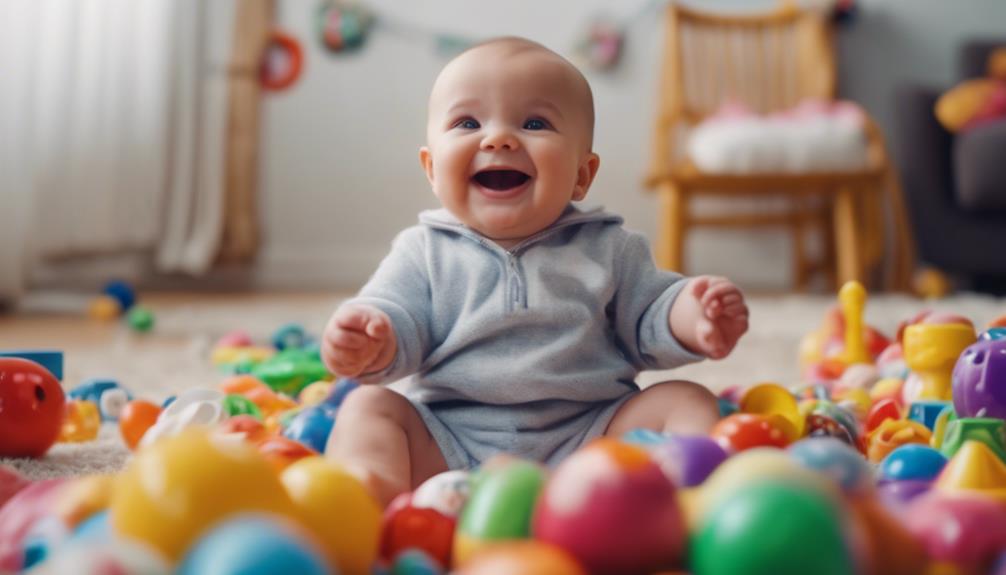
Around six to eight weeks of age, infants typically begin to develop the ability to smile. By gazing at faces and broadening their visual focus, babies learn to express their emotions through smiles.
Early smiles may serve as important social cues, laying the foundation for future social interactions and relationships.
Smiles and Social Bonds
Smiling emerges as a significant developmental milestone in infants around 6-8 weeks, indicating their growing social engagement and emotional connections. As babies start to interact with the world around them, their smiles play an essential role in forming social bonds and connecting with caregivers and peers.
Here are five key points to help you understand the importance of smiles in building social relationships:
- Babies use smiles to communicate pleasure, excitement, and happiness with those around them.
- Social smiling reflects improved visual recognition of faces and a developing ability to connect emotionally with others.
- Early smiling behaviors can predict positive personality traits and social competencies in the future.
- Smiling is a fundamental step in infants' social development, enabling shared experiences and emotional connections with caregivers and peers.
- Recognizing and responding to your baby's smiles can strengthen your bond and support their social and emotional growth.
Smile as Communication
As babies develop, their smiles serve as an essential form of communication, reflecting their growing social awareness and connection with others. Baby smiles, particularly social smiling, play a vital role in how infants interact with the world around them. Here is a table highlighting key developmental milestones related to baby smiles:
| Developmental Milestones | Description |
|---|---|
| Social Smiling | Typically begins around 6-8 weeks, showing improved vision and recognition of faces. |
| Early Smiles | May lack embedded emotion but act as social signals for infants to learn joy through interactions. |
| Anticipatory Smiling | Emerges around 8-12 months, indicating positive emotions and the ability to predict future social behavior. |
| Societal Participation | Social smiling helps babies prepare for engaging in society by sharing positive experiences with others. |
| Communicative Aspects | Research emphasizes that infant smiling is not solely about inner emotion but also highlights its social and communicative roles. |
Understanding these developmental stages can provide insights into the significance of baby smiles in communication and social interaction.
Signs of a Happy Baby
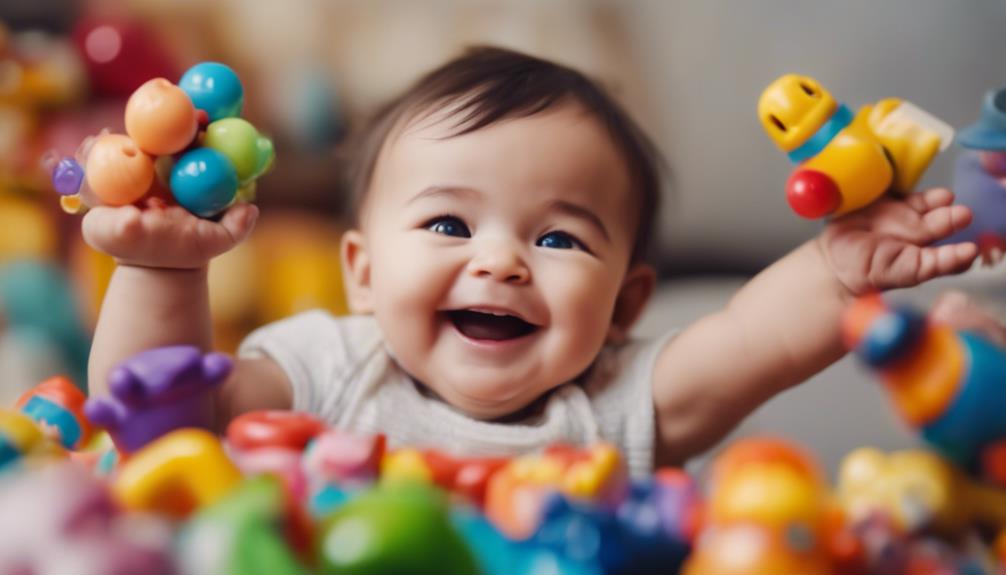
You can easily identify a happy baby by observing their consistent wide smiles and joyful expressions. Here are some signs that indicate a baby is content and happy:
- The baby displays a wide smile with an open jaw, resembling excitement.
- They smile frequently, even without direct interaction, as a form of expression.
- Extended periods of smiling, akin to a 'perma-smile,' signify a joyful disposition.
- Contrasting behavior to siblings or other babies may indicate an overly happy nature.
- Social and responsive smiles in various situations demonstrate the baby's happiness and excitement.
These signs collectively point towards a happy baby who's experiencing joy and contentment.
Observing these behaviors can help caregivers and parents understand the emotional state of the baby and provide appropriate care and support.
When to Seek Pediatric Guidance

If your baby exhibits delays in social smiling behaviors, it may be important to seek pediatric guidance. By six months of age, babies typically start making eye contact while smiling. Lack of direct gaze during smiling can be overwhelming for some infants, hindering their social development.
It's essential for babies to begin looking at faces for longer periods as they grow, as this helps them in recognizing voices and facial expressions. While some babies may initially smile without making direct eye contact as they learn these skills, persistent delays in social smiling behaviors should prompt a consultation with a healthcare provider.
Seeking pediatric guidance will allow for a thorough assessment and appropriate interventions if needed. Remember, early intervention can often address concerns more effectively, supporting your baby's social and emotional development.
Factors Influencing Baby's Smiling
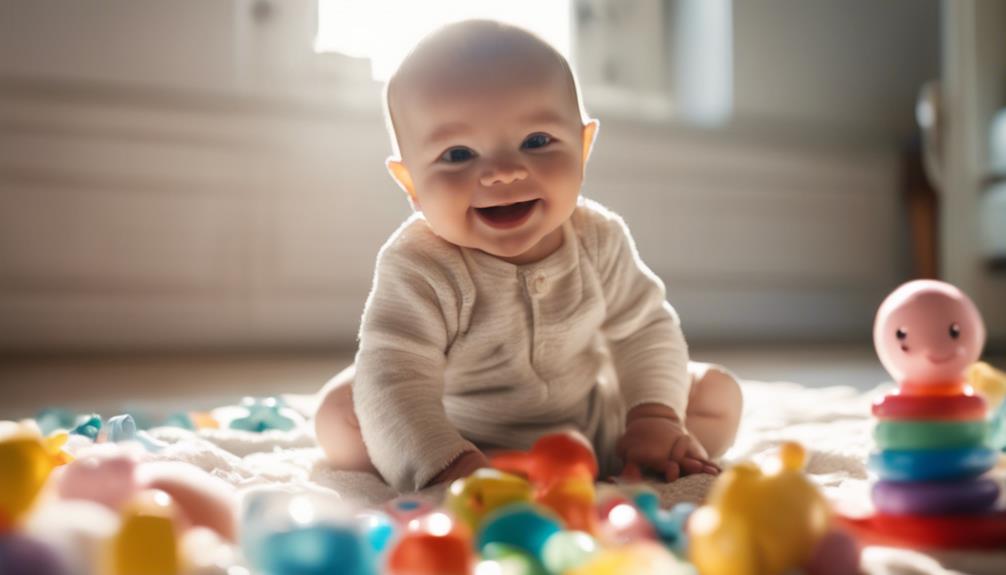
Factors influencing a baby's smiling can be influenced by various stimuli and social interactions. When it comes to your little one's first smiles, consider these factors that play a role in their whole face lighting up with joy:
- Social stimuli: Infants start socially smiling around 6 to 8 weeks in response to stimuli like faces or voices, as a way to elicit smiles back from caregivers.
- Familiar faces: As babies' vision improves, they may smile more at familiar faces, showcasing their growing social awareness.
- Learning joy: Smiling is a social signal for infants to learn joy by sharing it with others, enhancing their emotional development.
- Anticipatory smiles: Anticipatory smiles appearing around 8-12 months predict future social behavior and competence in infants, reflecting their developing social skills and interactions.
- Caregiver interactions: Positive interactions with caregivers can also profoundly influence a baby's smiling behavior, fostering a sense of security and happiness in the little one.
Interpreting Different Types of Smiles
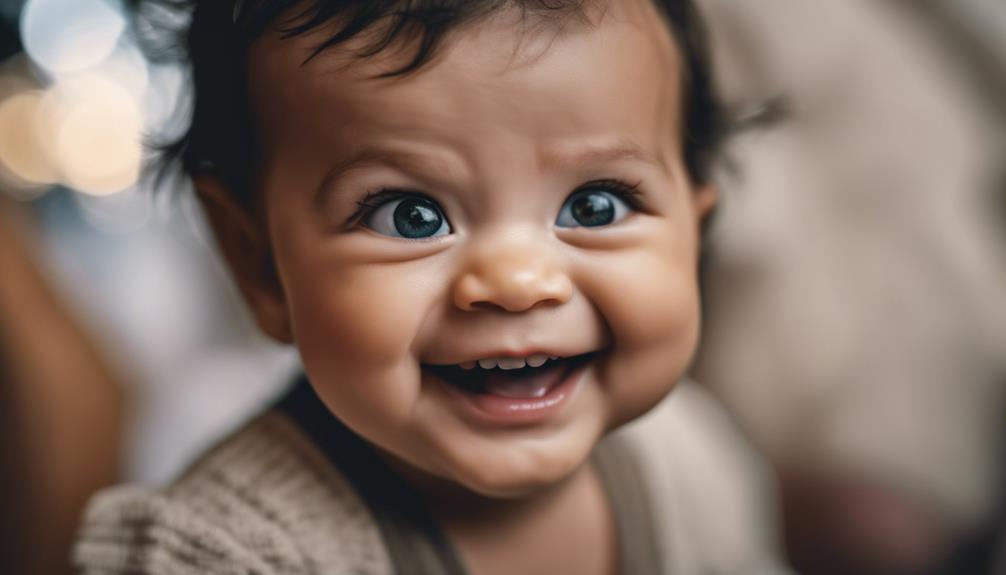
Understanding the different types of smiles in infants provides valuable insights into their evolving social communication skills and emotional development.
In the first six months of life, babies exhibit a range of smiles that reflect discrete emotions and intentions. Duchenne smiles, characterized by raised cheeks and pinched eyes, indicate a high level of engagement and focus. These smiles often signal genuine joy and connection with their caregivers.
On the other hand, mouth-open smiles in infants are typically playful and expressive of excitement. Simple smiles, without cheek-raising or mouth opening, may suggest a more cautious approach to social interaction. Different circumstances can elicit these various types of smiles, highlighting the complexity of infant communication.
As babies grow, their early smiling exchanges evolve into more sophisticated forms of interaction, laying the foundation for future social development and emotional expression. By observing and interpreting these different types of smiles, parents and caregivers can better understand and respond to their baby's emotional cues, nurturing a strong bond and supporting their overall happiness.
Nurturing Your Baby's Happiness
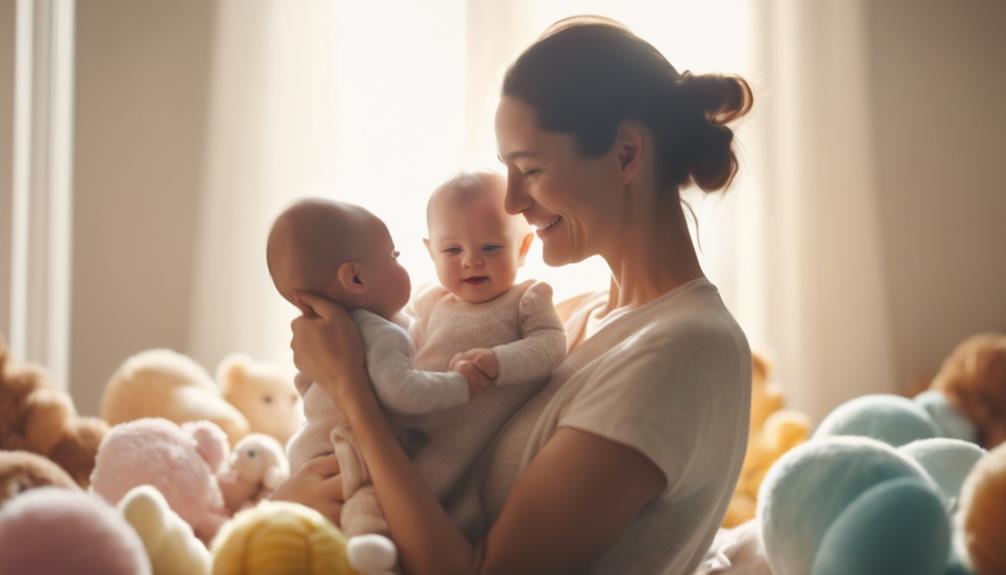
Nurture your baby's happiness by responding positively to their smiles and engaging in joyful interactions. Encourage a positive environment for your baby by fostering love and support that enhances their emotional well-being.
- Engage in activities that make your baby smile, such as playing peek-a-boo, singing, or making funny faces.
- Respond promptly to your baby's cues for interaction, allowing them ample opportunities to express joy through smiling.
- Create a nurturing atmosphere filled with laughter and positivity to promote your baby's happiness.
- Share special moments of joy with your baby to strengthen your bond and support their overall development.
- Remember that your baby's smiles are a reflection of their happiness and well-being, so cherish these moments and continue to nurture their positive emotions.
Celebrating Your Baby's Joy
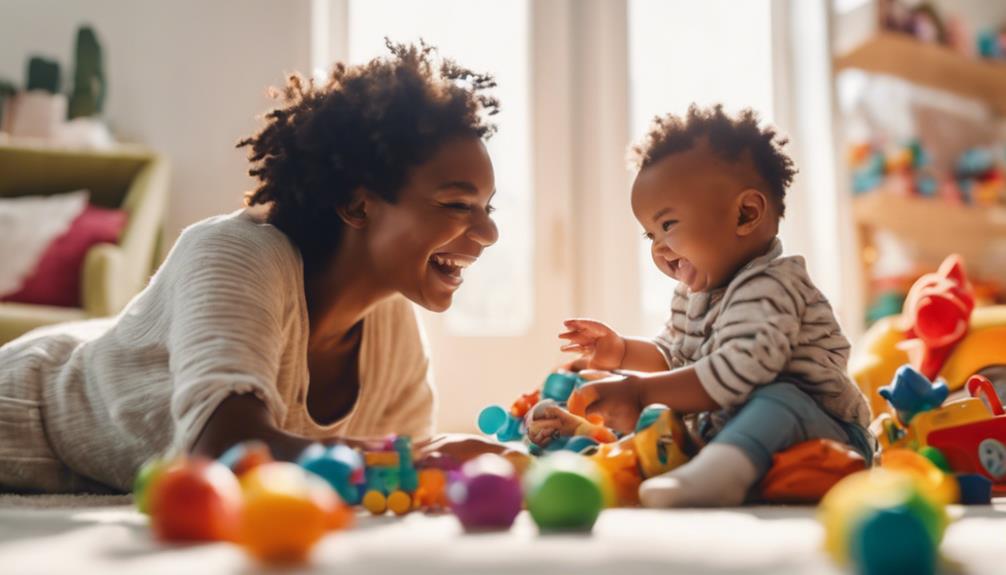
Embracing the exuberance of your baby's joy is a heartwarming experience that strengthens your bond and nurtures their emotional growth. Affective behavior, as studied by Daniel Messinger, highlights how babies' early smiles play a vital role in their social development.
When your baby smiles, they aren't just expressing happiness; they're also communicating with you and seeking positive responses. This social smiling marks a milestone where your baby begins to share goals with others, laying the foundation for future interactions.
Anticipatory smiles, emerging around 8-12 months, are particularly significant as they reflect positive emotions and even predict future social behavior. By celebrating your baby's joy and reciprocating those smiles, you're helping them prepare to engage with society, learn happiness through shared experiences, and express their emotions to connect with others in meaningful ways.
Frequently Asked Questions
Does Smiling Mean My Baby Is Happy?
When your baby smiles, it doesn't always mean they're happy. Babies smile for various reasons, like socializing or seeking attention. Smiling is their way of communicating and learning about the world around them, beyond just happiness.
Why Is My Baby so Smiley All the Time?
Your baby is so smiley all the time because smiling is a natural way for them to connect with you and others, aiding in their social, emotional, and visual development. It's a sign of their joy and learning process.
Why Is My Baby Smiling Without Reason?
Your baby smiles without reason because it's a natural way to communicate and connect. Around 38% of babies smile randomly to express emotions. It's their genuine way of interacting and exploring the world with joy.
Why Some Babies Are Always Happy?
Some babies are always happy due to their innate disposition towards positivity, genetic factors, and ability to engage joyfully with others. Their constant smiles reflect contentment, satisfaction, and developing social-emotional connections, making them naturally joyful.
Conclusion
To sum up, studies have shown that babies smile an average of 400 times a day, regardless of their mood or surroundings. Understanding the science behind baby smiles can help parents recognize and nurture their child's happiness.
By celebrating your baby's joy, interpreting different types of smiles, and seeking pediatric guidance when needed, you can guarantee your little one continues to light up your world with their infectious happiness.

